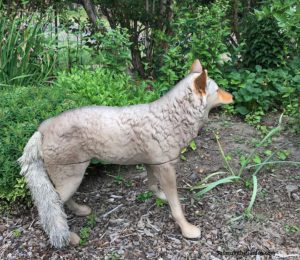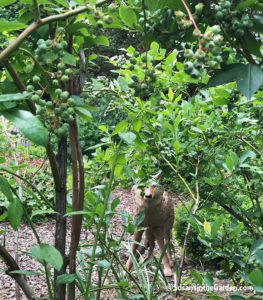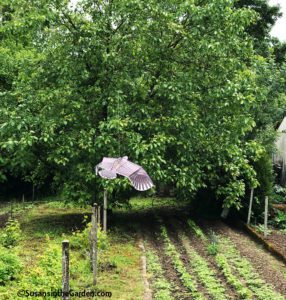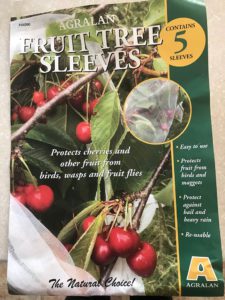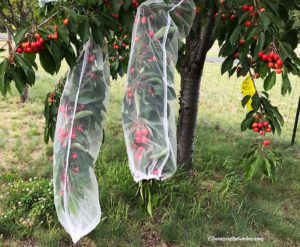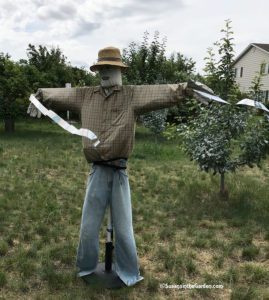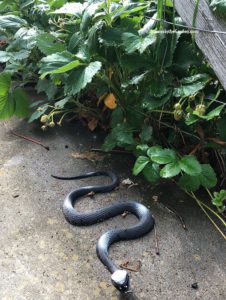July 14 Column: Creative Pest Control
As you probably know, we get plenty of critters in our garden. Many of them are certain the garden was planted specifically for them. Sometimes, dealing with them means you need to get creative. This year, Bill and I have found some new methods that are working pretty well. That’s the topic of my column today, which you can find in The Spokesman-Review: Creative garden pest control. (or you can read it lower in this post)
I wanted to share a little more information here, just in case it might help you, too. (and you’ll find this week’s “Everyone Can Grow a Garden” video at the bottom of this post)
In my column, I mentioned the coyote decoys we saw on the docks on Lake Coeur d’Alene. The purpose was to keep geese from pooping on the docks. I have to say those coyotes looked quite lifelike.
As soon as we got back home, I did a web search for “coyote decoys.” I found one sold by Walmart of all places! It cost $65, which is a bit of money, but it’s made well and it looks like a coyote.
We’ve been moving it around our vegetable garden to keep the quail away from the pea patch and cucamelons. Now “Wile E” (as in, Wile E Coyote, LOL) is guarding the blueberry and strawberry patch. It seems to be making a difference. I should add that every time I walk past the area, Wile E startles me because he looks so lifelike! (remember that you can click on any of these photos to view a larger image)
While leading a tour of French gardens recently, we spotted something interesting. There was a vegetable garden that had a hawk kite tethered to a pole. You can see what it looked like in the photo at left.
A light breeze was blowing and that kite really looked like a hawk hovering in the garden. I pointed it out to Bill and immediately made a mental note to check into them when we got back home.
Well, I did find one on Amazon that looks remarkably like a red-tailed hawk. It cost $19, which seemed reasonable, so we ordered one. Bill figured out a way to suspend it over the orchard because the darned robins keep eating our ripening cherries. As you can see by the video below, it really looks good. It’s been quite windy lately, so Mr. Hawk is getting a workout! But we are very impressed with it and are so glad we saw it in action in that French garden.
When I was at the Chelsea Flower Show last year, I stopped by the Agralan vendor booth. I noticed they sold a lot of organic products and love learning about new methods.
One of their products really got my attention: fruit tree sleeves (see photo). They’re made from a very fine, but durable, nylon mesh. The purpose is for covering the branches of cherry trees and other fruits to keep birds, wasps and cherry fruit flies away. Eureka! I decided to purchase a package of 5 sleeves. Yes, I know our cherry trees have way more than 5 branches, but I really wanted to try them out.
The sleeves are about 10″ wide by about 36″ long, and are open on each end. You slip a sleeve up over a branch and loosely cinch up each end with the draw strings. We’ve put them onto the branches on a couple of trees and I think it’s going to work GREAT! I’m very excited about this.
You put the sleeves in place once the blossoms have dropped and the small cherries start to develop.
Unfortunately, the fruit tree sleeves are only available in the U.K. Because they’re not available locally, I’m thinking of sewing a few more sleeves using floating row cover instead of the mesh.
You might also recall that we made a scarecrow named “Digby” a few weeks back (see video). That was a fun project and it seems to be helping but some birds aren’t all that worried about him! Bill has added a bit of flash tape to Digby’s arms to make him a bit more scary.
The following methods that we also employ are not new to us. We’ve been using them for years and they are also helpful:
Flash tape _ This wide mylar ribbon flashes and rustles in the breeze (see on Digby). It is very effective and if you take good care of it, the ribbon will last for years. Even though it is referred to as a “tape,” it doesn’t have any adhesive on it. We use the 2″ wide ribbon.
Toy snakes _ These rubber snakes make visitors to our garden jump on occasion but they’re totally harmless! We bought a bunch at the dollar store. We use them as a deterrent to keep quail and other birds away. They work pretty well. Just remember to move them from time to time.
Important things to remember:
Move these deterrents around. Don’t keep them in the same place day after day, birds and other critters will realize there’s nothing to fear. They’ll go right back to being bothersome.
Put the deterrents in place right when you need them. Remove them as soon as you don’t, so pests don’t get habituated to them. This is REALLY important, folks! As soon as we’ve harvested our cherries, the mylar ribbon, hawk kite and fruit tree sleeves will be put away. We fully intend to relocate the hawk kite to the blueberry patch so it can work its robin- and starling-repellent magic and protect our crop.
OK, here is this week’s video. The topic? What we’re growing to attract pollinators. This includes an update of the new pollinator garden we added to the front yard in May.
Creative Pest Control garden column:
by Susan Mulvihill
I love growing vegetables, berries and tree fruits, I’m always looking for new ideas to keep certain types of pests away. Over the years, I’ve found this requires a creative approach.
Recently, my husband and I had lunch in Coeur d’Alene. While enjoying the view of the lake out the window, I noticed some coyote decoys on the docks. They were there to keep geese from spoiling the docks and looked quite lifelike.
I later did a web search for coyote decoys and found the same type for $65. I placed my order and now “Wile E Coyote” guards different areas of our garden. His duties alternate between keeping the quail away from the pea patch and cucamelon vines, and guarding the blueberry patch. I walk past an area where he’s on duty, I’m briefly startled because he’s so lifelike.
While we were in France last month, we walked past a garden with a hawk kite tethered to a pole. In the gentle breeze, the kite was quite convincing as it soared over the garden. We’d also noticed some farmers’ fields with more hawk kites. The purpose was to keep birds and rabbits away from the crops.
Bill and I decided to look for a hawk kite once we returned to Spokane. It was easy to find and, $19 later, Bill rigged one to soar above our small orchard. Our main goal was to keep the robins, finches and starlings away from our ripening cherries. It has worked pretty well.
Another product we’ve used to startle the birds is 2-inch-wide mylar flash tape. We tie it to a few fruit tree branches and also attach it to the top of some PVC poles. Whenever the wind blows, it flashes and rustles and is erratic enough to upset the birds.
We’re currently testing some fruit tree sleeves — made from a tight nylon mesh — to cover branches laden with cherries. The 3-foot-long sleeves are slipped onto the branches and secured at each end with a drawstring.
Earlier in the season, I made a life-sized scarecrow named “Digby.” In addition to using it for the usual purposes, we also thought it would look cool in the garden. Well, it seems to be doing more of the latter. While finches and starlings have been deterred, the robins are determined to eat some fruit and berries. Our neighbors enjoy pointing out how much Digby looks like Bill. That’s because he’s been outfitted with an old pair of his jeans and a flannel shirt. I’m glad we provide our neighbors some amusement relating to what “those crazy Mulvihills” are up to.
Toy snakes are yet another example of being creative about pest control. Several years ago, we purchased several at a dollar store. They look lifelike enough to occasionally startle a visitor to the garden. But the purpose is to keep birds — especially quail — away from newly-sprouted seeds and tender young plants.
When using any type of deterrent, there are two important things to remember:
Move it around in your garden. Keeping in the same place day after day makes birds and other critters realize there’s nothing to fear. Put the deterrents in place right when you need them. Remove them as soon as the need has passed, so pests won’t become habituated to them.

